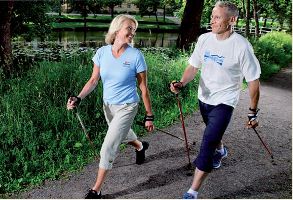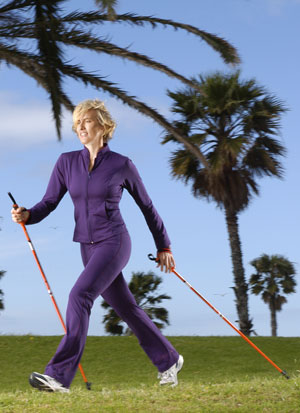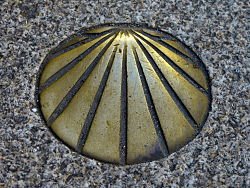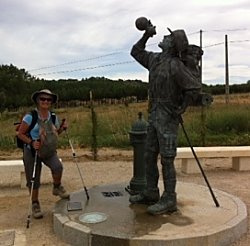NORDIC WALKING
An Effective Exercise Option
Nordic Walking is a fitness activity that enhances the natural walking movement by the addition of specifically designed walking poles. Nordic Walking has become a worldwide phenomenon as people discover the health and fitness benefits of this unique and effective form of exercise.
 Nordic Walking is a fitness activity that enhances the natural walking movement by the addition of specifically designed walking poles. Nordic Walking has become a worldwide phenomenon as people discover the health and fitness benefits of this unique and effective form of exercise.
Nordic Walking is a fitness activity that enhances the natural walking movement by the addition of specifically designed walking poles. Nordic Walking has become a worldwide phenomenon as people discover the health and fitness benefits of this unique and effective form of exercise.
Originally used by the Scandinavians, as a summer training regime to duplicate X-country skiing, Nordic Walking started to become mainstream in the late 1990’s, with the development of specific one piece carbon fibre poles. (It must be stressed that Nordic Walking poles are entirely different to tramping poles. In NZ, poles are generally purchased from a certified* Instructor, after a course of Instruction).
While Nordic Walking is first and foremost a fitness activity, many health benefits have been attributed to this exercise. Walking with Nordic Walking poles involves the use of the arms and upper body, thereby increasing the energy (calorie) expenditure. You are using 90% of your muscles 100% of the time!
It is highly recommended that you learn Nordic Walking from a certified* Instructor, to ensure you get the best instruction. Once you have learned the correct technique, you can gain more effective energy usage (>20%) in less time, which is ideal for those people who have a lower fitness capacity, are overweight or have mobility issues. Physical activity is recommended to Diabetics as a way of mitigating the effects of high, circulating blood sugar levels. Compared to regular walking, the higher energy use while Nordic Walking may have a positive impact on managing these levels.
To summarize the acute physiological effects of Nordic walking, it increases the energy consumption of the body, compared to regular walking with the same speed, without poles, both in women and men and in fit and less fit individuals ... (Diabet. Med. 28, 1362–1372 (2011)).
Once you are correctly sized for the poles, you will notice an immediate improvement in your posture. It is amazing that 70% of our body weight is above the hips. When we walk, most of the upper body is “carried” like a passenger in a car. As a result, our posture can slump if the upper body does not have an active movement, during walking.
The improvement to posture ensures the flow of gravity moving through our body is properly aligned. The poles also provide stability during the walking movement as you now have a second “foot” on the ground. This improves balance and reduces the joint load, making the walking movement more effective and ... smarter! This may ultimately reduce stress on the feet. Those people suffering from diabetic peripheral neuropathy (reduced circulation in the feet and legs) need to avoid hard pathways and walk on softer surfaces, such as grass or firm sand.
Whenever we exercise, we tend to work at a level dependent on our perceived exertion level. As the exercise intensity increases, our perception also increases (along with our heart rate). Therefore, we adjust our effort to suit our fitness level. However, the rate of perceived exertion in Nordic Walking is lower. This means that if you have reduced fitness, you can maintain the activity longer. Furthermore, a person who is of higher fitness can continue the activity at a heart rate level similar to running.
... perceived exertion in pole walking is often less than true physiological strain ... The resulting increases in energy consumption and heart rate in Nordic walking mean that the cardiovascular strain induced by Nordic walking is greater compared to walking without poles at the same speed. This is desirable for those people who have difficulty reaching their training heart rate by walking - instead of having to start running they can start using walking poles and continue walking. Walking involves less harmful impact to the lower extremities compared to running, and therefore may prevent from (sic) injuries. (Diabet. Med. 28, 1362–1372 (2011)).
The benefits of Nordic Walking also extends to individuals with Parkinson’s (PD) and other neurological conditions; multiple sclerosis (MS); chronic obstructed pulmonary disease (COPD); arthritis; stroke recovery; joint replacements; obesity; fibromyalgia; breast cancer recovery and other limitations to walking.
This is not forgetting that many fit and well people use Nordic Walking as an effective and smarter way of exercising, which is low impact and a total body workout.
Physical activity is vital to good health and Nordic Walking could be the perfect exercise solution to help diabetes sufferers’ exercise more effectively.
(Article written and researched by June Stevenson, Nordic Walking Coach)
*June Stevenson is the NZ National Nordic Walking Coach on behalf of the International Nordic Walking Federation (INWA). She is a Registered Exercise Consultant and Health and Fitness Trainer.
 Who would ever imagine a couple of spike-tipped poles having the power to transform a ho-hum exercise like walking into a dynamic, must-do activity?
Who would ever imagine a couple of spike-tipped poles having the power to transform a ho-hum exercise like walking into a dynamic, must-do activity?
 2
2 3
3



